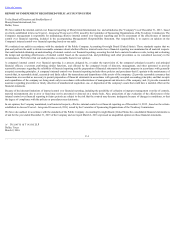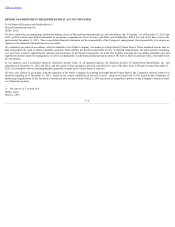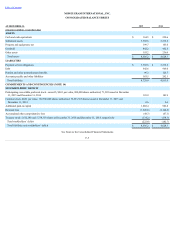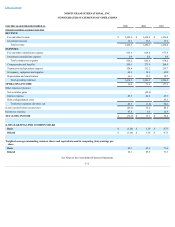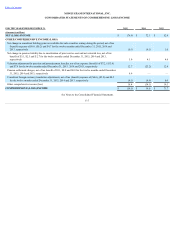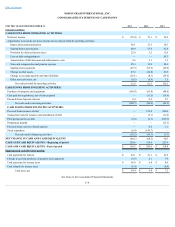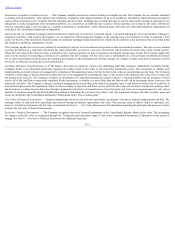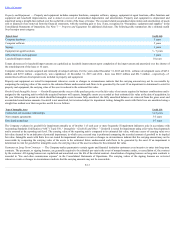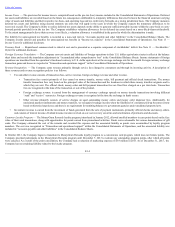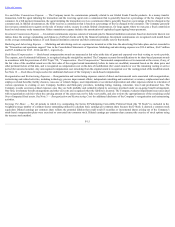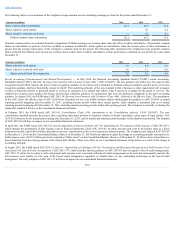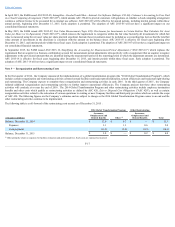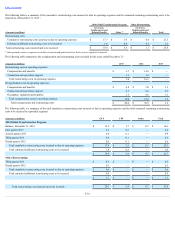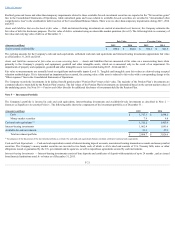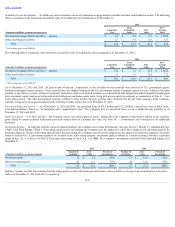MoneyGram 2015 Annual Report Download - page 77
Download and view the complete annual report
Please find page 77 of the 2015 MoneyGram annual report below. You can navigate through the pages in the report by either clicking on the pages listed below, or by using the keyword search tool below to find specific information within the annual report.
Table of Contents
PropertyandEquipment — Property and equipment includes computer hardware, computer software, signage, equipment at agent locations, office furniture and
equipment and leasehold improvements, and is stated at cost net of accumulated depreciation and amortization. Property and equipment is depreciated and
amortized using a straight-line method over the useful life or term of the lease or license. The cost and related accumulated depreciation and amortization of assets
sold or disposed of are removed from the financial statements, with the resulting gain or loss, if any, recognized in “Occupancy, equipment and supplies” in the
Consolidated Statements of Operations. See Note 7 — PropertyandEquipmentfor additional disclosure. The following table summarizes the e stimated useful
lives by major asset category:
Type of Asset Useful Life
Computer hardware 3 years
Computer software 5 years
Signage 3 years
Equipment at agent locations 3 - 7 years
Office furniture and equipment 7 years
Leasehold improvements 10 years
Tenant allowances for leasehold improvements are capitalized as leasehold improvements upon completion of the improvement and amortized over the shorter of
the remaining term of the lease or 10 years .
Computer software includes acquired and internally developed software. For the years ended December 31, 2015 and 2014 , software development costs of $47.2
million and $25.9 million , respectively, were capitalized. At December 31, 2015 and 2014 , there was $86.9 million and $61.5 million , respectively, of
unamortized software development costs included in property and equipment.
Property and equipment are tested for impairment whenever events or changes in circumstances indicate that the carrying amount may not be recoverable by
comparing the carrying value of the assets to the estimated future undiscounted cash flows to be generated by the asset. If an impairment is determined to exist for
property and equipment, the carrying value of the asset is reduced to the estimated fair value.
GoodwillandIntangibleAssets — Goodwill represents the excess of the purchase price over the fair value of net assets acquired in business combinations and is
assigned to the reporting unit in which the acquired business will operate. Intangible assets are recorded at their estimated fair value at the date of acquisition. In
the year following the period in which identified intangible assets become fully amortized, the fully amortized balances are removed from the gross asset and
accumulated amortization amounts. Goodwill is not amortized, but is instead subject to impairment testing. Intangible assets with finite lives are amortized using a
straight-line method over their respective useful lives as follows:
Type of Intangible Asset Useful Life
Contractual and customer relationships 3-15 years
Non-compete agreements 3-5 years
Developed technology 5-7 years
The Company evaluates its goodwill for impairment annually as of October 1 of each year or more frequently if impairment indicators arise in accordance with
Accounting Standards Codification (“ASC”) Topic 350, “ Intangibles-GoodwillandOther.” Goodwill is tested for impairment using a fair-value based approach
and is assessed at the reporting unit level. The carrying value of the reporting unit is compared to its estimated fair value, with any excess of carrying value over
fair value deemed to be an indicator of potential impairment, in which case a second step is performed comparing the recorded amount of goodwill to its implied
fair value. Intangible assets with finite lives are tested for impairment whenever events or changes in circumstances indicate that the carrying amount may not be
recoverable by comparing the carrying value of the assets to the estimated future undiscounted cash flows to be generated by the asset. If an impairment is
determined to exist for goodwill or intangible assets, the carrying value of the asset is reduced to the estimated fair value.
PaymentsonLong-TermContracts — The Company makes payments to certain agents and financial institution customers as an incentive to enter into long-term
contracts. The payments, or signing bonuses, are generally required to be refunded pro rata in the event of nonperformance under, or cancellation of, the contract
by the customer. All signing bonuses are capitalized and amortized over the life of the related contract. Amortization of signing bonuses on long-term contracts is
recorded in “Fee and other commissions expense” in the Consolidated Statements of Operations. The carrying values of the signing bonuses are reviewed
whenever events or changes in circumstances indicate that the carrying amounts may not be recoverable.
F-13


